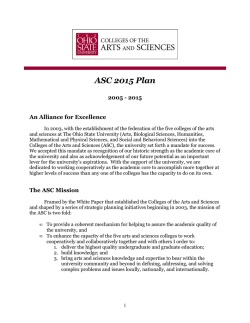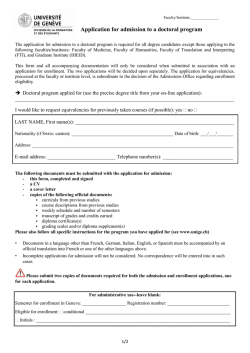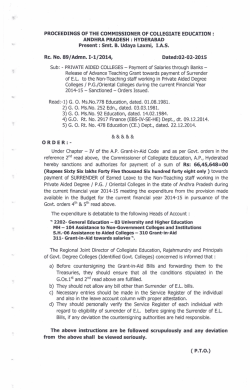
FAQ - Wisconsin HOPE Lab
Frequently Asked Questions About President Obama’s Free Community College Proposal Sara Goldrick-Rab Founding Director, Wisconsin HOPE Lab Professor of Educational Policy Studies and Sociology University of Wisconsin-Madison January 29, 2015 Since President Obama announced plans to offer community college tuition-free to some Americans, I have received and responded to a lengthy list of questions from those interested in the plan and its implications. Here are the 10 most frequently asked questions and my responses, informed by research (mine and that of others), policy analysis, and discussion with key experts. 1. What happens to Pell Grants under this plan? • • Students qualifying for the Pell Grant based on the federal needs analysis will continue to receive it. Pell recipients can use those funds to pay for non-tuition costs of attending college, which are substantial (see the next question). The Obama administration is not calling for reductions in support for Pell to pay for this program, and any political action to do so would undermine the program itself. It should be noted that for more than 30 years, the purchasing power of the Pell Grant has eroded absent a free-tuition program.i It is unlikely that this trend will be reversed or exacerbated by this new program. 2. Low-income students already pay no tuition for community college, thanks to the federal Pell Grant and state aid. How does this help them? • • Average published tuition and fees at community college are $3,347 for 2014-15, according to the College Board.ii But the full cost of attending community college (using the federal definition, which also includes books and supplies and an allowance for living costs) is $16,325. Successful college students cover those costs without full-time work so that they can focus on classes and studying. Low-income students do receive grant aid that reduces those costs. But the average net price they faced in 2011-2012 (cost of attendance minus all grant aid, latest available data) was $8,300 for dependents, and $11,400 for independents. When considering their annual incomes, this is clearly a substantial amount of money—low-income dependents earned an average of just $21,000 a year and low-income independents earned an average of $2,039.iii L139 Education Building | 1000 Bascom Mall | Madison, WI 53706 www.wihopelab.com • The net price faced by low-income students at community college would be substantially reduced if tuition were removed as a cost. Since this is a “firstdollar” program, they can apply grants to reducing the remaining costs. For example, low-income dependent students would face a revised net price of ~$5,000, representing a much more manageable (yet still substantial) 23 percent of annual income, compared to 40 percent now. Critically, that amount can be covered with a subsidized federal loan and a modest amount of work. 3. Isn’t this plan regressive, primarily benefiting wealthy families? • • • Given the facts stated above, it should be clear that low-income students receive the greatest total subsidy under this plan. Moreover, the individuals most in need of this plan are not represented among today’s college students—they are the prospective students from the bottom quarter of the income distribution. Consider that today just 29 percent of individuals from the bottom 25 percent enter college, compared to 80 percent of those from the top 25 percent. Substantially reducing the cost of college attendance, research shows, will increase enrollment in community college among students who currently do not attend.iv This should increase representation of low-income Americans among undergraduates. A growing body of rigorous research evidence also suggests that lowering the cost of attending college is likely to increase persistence and degree completion among both low-income students and lower-middle-class (moderate-income) students. At community colleges, degree-completion rates among academically talented low- and moderate-income students are declining. Reversing this trend is particularly important for increasing overall degree production.v Finally, decades of research clearly indicate that the cost of college attendance is not an important decision criterion for wealthy families, and students from these families do not benefit from cost reductions when it comes to degree completion. Merit-based financial aid programs are largely unsuccessful for this reason. This program is highly unlikely to induce wealthy students to attend community college rather than their preferred schooling options, as studies show they prioritize prestige and related factors in their college selections. But it should help middle-class families, many of whom have suffered real declines in their wages and are struggling to hold on to their middle-class status. 2 4. This plan will drive students to attend community colleges, where success rates are notoriously low. Won’t this decrease overall degree attainment and hamper social mobility? • • Completion rates at community colleges are partly a function of the financial struggles of the students they enroll. These effects are multi-faceted, interactive, and therefore difficult to estimate.vi Not only are students with insufficient financial resources more likely to leave college, but supporting these students also requires substantial institutional resources. Students who work longer hours to pay for school are more likely to have academic struggles and require advising for those needs. Students who are forgoing secure and stable food and housing in order to pay for tuition or books are more likely to suffer emotional, mental, and physical challenges that make it harder for them to learn. Faculty and staff who come into contact with impoverished students on a daily basis spend a great deal of time and effort counseling them, and report emotional exhaustion and burnout. Reducing the financial stress and strain faced by community college students will surely increase rates of degree completion.vii In order for increased community college attendance to decrease social mobility, we would have to observe a reduction in the number of students obtaining any postsecondary education and/or an economic penalty for college attendance. This is the inverse of what empirical evidence predicts will occur. The fraction of students attending college should rise; completion rates should as well, even among students who choose community college over a four-year institution because of lower costs. Economist Jeff Denning, at the University of Texas at Austin, recently found that a $1,000 decrease in community college tuition increased immediate transition from high school to community college by 5.1 percentage points. Community college enrollment in the first year after high school increased by 7.1 percentage points for a $1,000 decrease in tuition. Lower tuition also increased enrollment in community college every year for six years after high school graduation and increased transfers from community colleges to universities. Moreover, Denning found that attending a community college increased the probability of earning a bachelor’s degree within eight years of high school graduation by 23 percentage points for students who would not have attended any college in the absence of reduced tuition. He also found that community college attendance increased bachelor's degree attainment even for students who initially diverted enrollment from universities to community colleges. viii 3 5. Will this plan help students attend college but not necessarily graduate, and isn’t that a bad thing? • • Despite the recent attention to the college completion agenda, economic and social returns to some college attendance persist. Each year of postsecondary education credits has value, and while that value is undermined by student debt, reducing costs reduces that debt. While a degree generates a bigger return, no degree is required to generate an improvement over a high school degree.ix While it would be preferable to design a more robust policy full of the sorts of institutional supports required to help all low-income students complete degrees, such a policy would have a larger price tag. The perfect should not be the enemy of the good; increasing access substantially and persistence modestly is a very good place to start. 6. What if this plan leads students for whom “institutional fit” is important to choose to attend a community college rather than one where they are better matched? • • Numerous surveys and studies have found that the cost of attending college is the greatest influence on college choice decisions of low- and middle-income students. That fact represents the status quo—institutional fit is a luxury that most cannot afford. Reducing the cost of attending college should allow more students to select a college that suits them, not fewer. There are some studies that suggest an academic “mismatch” occurs when academically talented students attend community college rather than four-year institutions and that this inhibits degree completion. Other studies dispute this finding. What seems clear, however, is that the fraction of undergraduates who are on the margin between choosing a community college or a selective fouryear institution is very small. (More students are choosing between a nonselective four-year institution and a community college, and for these students the choice makes relatively little difference.) The “community college penalty” mainly applies to the small number of students qualified for selective colleges, and lowering the price of attending community college is unlikely to make a difference for the vast majority of their peers for whom a selective college is not an option.x 7. This program is based on an untested state program in Tennessee. Why advance this proposal before the results of that experiment are in? What is the empirical basis for this proposal? • First, while this program was inspired by efforts to make community college free in Tennessee, its details are not based on Tennessee’s model. Most importantly, that effort is a last-dollar program that distributes the most resources to non-Pell recipients. Watching results from Tennessee over time would not help policymakers predict success for this new effort, though lessons for messaging and implementation might be gleaned. 4 • The empirical basis for this proposal lies in three types of studies: (a) the effects of financial aid on community college students, (b) the effects of increased community college funding on enrollment, and (c) the effects of reduced community college tuition. I am working on a thorough outline of all of the studies included herein, but for now here is a summary: o Studies of the impacts of grant aid on community college students tend to find modest, positive effects. The aid generally provides a modest reduction in the costs of attendance; the president’s plan reduces the costs more than most of the evaluated aid programs do. o There is just one study in the second category, and it finds that bonds for community colleges increase community college enrollment and decrease enrollment in the for-profit sector.xi o Denning’s research, described above, is the most rigorous study to date on the effects of reducing community college tuition. In addition, there was a 30-year evaluation of the impact of eliminating tuition and admissions standards at the City University of New York in the early 1970s. In three books, scholars have documented the impacts of that natural experiment, finding that more than 70 percent of the women who entered college under those conditions (and otherwise would not have) completed their degrees. They went on to earn significantly higher incomes, accumulated more assets, had a greater chance of marrying, demonstrated better parenting skills, and showed a greater capacity to encourage educational achievement in their children.xii 8. How will states ever afford to participate in this plan? • • Community colleges are currently heavily reliant on states for financial support, as state and local funding are their main sources of revenue. As state support has declined, tuition has risen at community colleges. Under the president’s plan, federal support for community colleges increases substantially. Instead of paying 75-100 percent of appropriations for community colleges, states need only fund 25 percent of appropriations. Yes, those appropriations must cover the amount that is now charged as tuition. However, efficiency gains are very likely, as students move through the system more quickly. Thus, there is as much reason to expect a reduction in burden on states, as there is reason to predict an increase. 5 9. Doesn’t this plan require more from community colleges than they can handle? • • As noted earlier, community colleges are burdened in part by the financial stress of their students. That burden should be reduced under this plan. At the same time, enrollment will increase. This is not an uncommon experience for community colleges, which regularly experience ebbs and flows. In most states, enrollment is currently down from where it was several years ago. That said, of course enrollment increases must be accompanied by support, and must be planned for. Nancy Kendall and I are very clear about the need for this support in our writing on making college free.xiii 10. What will happen to other institutions of higher education under this plan? • Unlike the proposal Nancy and I wrote, this proposal does not eliminate support for private colleges and universities in order to fund the plan. But for policy purposes, the key question ought to be this: What are the implications for students—not schools per se, except to the extent that they improve student outcomes? For-profit higher education is most likely to be affected, as research indicates that increased funding for community colleges adversely affects enrollment in that sector.xiv 6 Endnotes i ii iii iv v vi vii viii ix x xi xii xiii xiv See Figure 3 in Goldrick-Rab, S. & Kendall, N. (2014). Redefining College Affordability: Securing America’s Future with a Free Two Year College Option. www.wihopelab.com Baum, S. & Ma. J. (2014). Trends in College Pricing. The College Board, Washington, D.C. See Table 1 in Goldrick-Rab, S. & Kendall, N. (2014). College Board data on net price shows similar but inappropriately counts tax credits as equivalent to grants in computations, understating the net price. Bailey, M. & Dynarski, S. (2011). "Inequality in Postsecondary Education," in Whither Opportunity? eds. Duncan, G. & Murnane, R. New York: Russell Sage. Denning, J. (2014). College on the Cheap: Cost and Benefits of Community College. Job Market Paper. www.jeffdenning.com See Figure 2 in Goldrick-Rab, S. & Kendall, N. (2014). Goldrick-Rab, S. (2010). Challenges and Opportunities for Improving Community College Student Success. Review of Educational Research, 80(3), 437-469. Broton, K., Frank, V., and Goldrick-Rab, S. (2014). “Safety, Security, and College Attainment: An Investigation of Undergraduates’ Basic Needs and Institutional Response.” www.wihopelab.com Denning, J. (2014). Hout, M. (2012). Social and Economic Returns to College Education in the United States. Annual Review of Sociology, Vol. 38: 379-400. Goldrick-Rab, S. (2010). Challenges and Opportunities for Improving Community College Student Success. Review of Educational Research, 80(3), 437-469. Brand, J. E., Pfeffer, F. T., & Goldrick-Rab, S. (2014). The Community College Effect Revisited: The Importance of Attending to Heterogeneity and Complex Counterfactuals. Sociological Science, 1, 448-465. Moltz, D. (2009). Crowding Out For-Profit Colleges. Inside Higher Ed. October 9. Attewell, P., Lavin, D., Domina, T., & Levey, T. (2007). Passing the Torch: Does Higher Education for the Disadvantaged Pay Off Across the Generations? New York, NY: Russell Sage. Lavin, D. E., & Hyllegard, D. (1996). Changing the Odds. Yale University Press, 92A Yale Station, New Haven, CT. Lavin, D. E., Alba, R. D., & Silberstein, R. A. (1981). Right versus privilege: The openadmissions experiment at the City University of New York. New York: Free Press. Goldrick-Rab, S. & Kendall, N. (2014). Moltz, D. (2009). 7
© Copyright 2025







